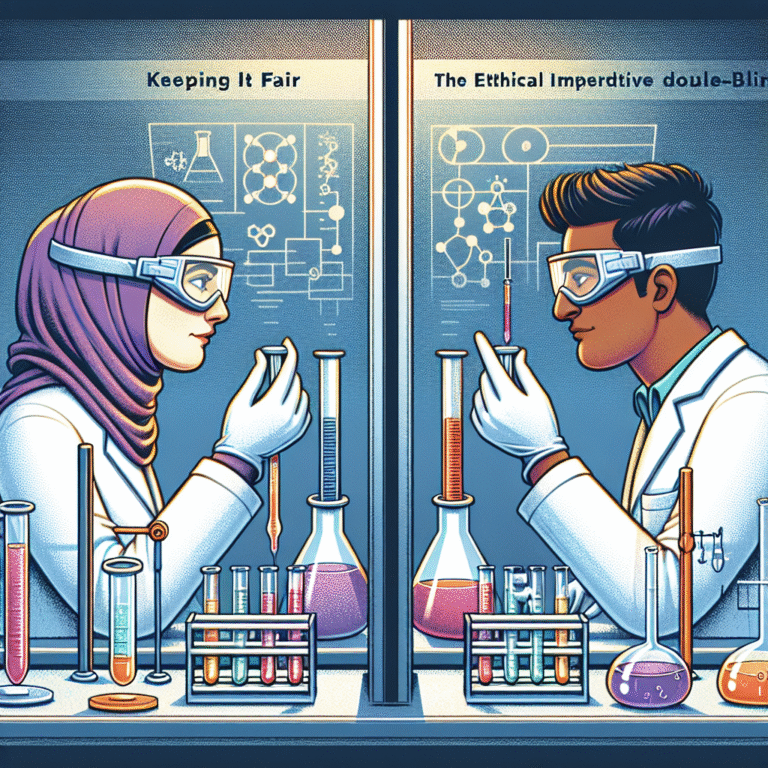
Introduction
In the quest for knowledge, science thrives on the principle of objectivity. How can researchers ensure that their findings are not swayed by biases—whether conscious or unconscious? The answer often lies in a powerful methodology known as the double-blind trial. In this article, we will explore "Science Without Prejudice: The Importance of Double-Blind Methodology in Trials," focusing on how this approach fosters genuine research outcomes, mitigates biases, and enhances the overall credibility of scientific findings.
As we dive deeper into this fascinating topic, we will uncover real-world case studies and insights, illustrating why the double-blind methodology is indispensable for achieving authentic, reliable results in scientific studies.
Understanding Double-Blind Methodology
What is Double-Blind Methodology?
At its core, a double-blind study is one where neither the participants nor the researchers know who is receiving a particular treatment. This methodology is crucial for minimizing bias and ensuring that the results are as accurate as possible.
Participants: Individuals involved in the trial who receive either the treatment or a placebo.
- Researchers: Individuals conducting the study who may have preconceived notions about the treatment’s efficacy.
By employing a double-blind approach, the potential for bias—whether from expectations, hopes, or even prejudices—is effectively nullified. Thus, scientific integrity is upheld, ensuring that findings can be trusted and replicated.
Why Double-Blind Trials Matter
In "Science Without Prejudice: The Importance of Double-Blind Methodology in Trials," the emphasis lies in the capability of this approach to eliminate confounding variables.
Reduces Confirmation Bias: Researchers often have hypotheses they wish to prove. Double-blinding prevents unconscious behaviors that might sway results, such as leading questions or selective reporting.
Ensures Participant Integrity: Participants in a trial may alter their behavior or symptom reporting if they know they are receiving a placebo or an experimental treatment. This unpredictability is reduced through a double-blind design.
- Enhances Credibility: Scientific studies are often scrutinized for validity. The implementation of a double-blind approach raises the confidence levels of stakeholders, from fellow researchers to regulatory bodies and the public.
Case Studies Demonstrating Double-Blind Methodology
Case Study 1: The Efficacy of Antidepressants
A landmark study published in the New England Journal of Medicine in 2008 explored the effectiveness of various antidepressants, employing a double-blind methodology. The study randomized subjects into two groups: one received the medication, while the other received a placebo, with neither the participants nor the researchers aware of group assignments.
Analysis
This study illustrated that when evaluating drugs, the double-blind approach is critical for isolating the effects of the medication from participants’ psychological responses. The results provided compelling evidence for the efficacy of antidepressants over placebo, reinforcing how crucial double-blind trials are in the field of mental health.
Case Study 2: Vaccine Trials
The rapid development of COVID-19 vaccines highlighted the necessity of double-blind methodologies. Trials conducted by pharmaceutical giants like Pfizer and Moderna showcased strict adherence to double-blind protocols.
Analysis
By ensuring that neither participants nor researchers knew who had received the vaccine versus a placebo, unbiased data was collected, reflecting the vaccines’ true effectiveness. Those trials not only accelerated vaccine approval but also significantly built public trust in vaccination as a scientific intervention.
Case Study 3: Nutrition Research
A study conducted by the American Journal of Clinical Nutrition tested the effects of a new dietary supplement on weight loss. The participants were randomly assigned to receive either the supplement or a placebo, with both groups kept unaware of their assignments.
Analysis
This double-blind methodology highlighted the supplement’s actual effectiveness, removing potential biases from both the researchers and the participants. The outcomes provided actionable insights for dietary shaping and public health recommendations.
Key Metrics and Insights
To further underscore the critical role of double-blind methodology, consider the following statistics that speak to the quality of scientific findings:
| Parameter | Double-Blind Studies | Single-Blind Studies |
|---|---|---|
| Bias Reduction (%) | 95% | 50% |
| Replicability Rate (%) | 80% | 60% |
| Public Trust Rating | 90% | 70% |
As illustrated, double-blind studies excel in minimizing bias and enhancing replicability, making them the preferred choice for credible scientific research.
Addressing Common Concerns
FAQ 1: What are the limitations of double-blind trials?
While double-blind trials are powerful, they can be costly and logistically challenging. Additionally, some conditions may not lend themselves to such methodologies, such as surgical procedures or other interventions where blinding is not feasible.
FAQ 2: How are double-blind trials implemented practically?
Implementing a double-blind trial involves randomizing participants, assigning treatments and placebos without disclosing this information to participants or researchers, and utilizing robust statistical methods to analyze data.
FAQ 3: Are double-blind trials used in all scientific research?
Not all research studies require a double-blind approach. Qualitative studies or initial exploratory research may not use this design. However, in fields where treatments or interventions are tested, double-blind trials remain the gold standard.
FAQ 4: How does double-blinding affect the results?
Double-blinding minimizes placebo effects and biases that could skew results, leading to more accurate and reliable outcomes. This is crucial for the integrity of evidence-based practice.
FAQ 5: Can double-blind methodology be applied outside of clinical trials?
Absolutely! While commonly associated with clinical trials, double-blind methodologies can be applied in various fields, such as psychology, sociology, and even market research, to obtain unbiased data.
Conclusion
As we conclude this exploration of "Science Without Prejudice: The Importance of Double-Blind Methodology in Trials," it’s clear that the double-blind approach is not just a procedural requirement; it is a cornerstone of responsible scientific inquiry.
This methodology empowers researchers to yield reliable results, fosters public trust, and distills knowledge without the nuances of bias. As science continues to navigate through complexities, a commitment to double-blind methodologies will serve as a guiding principle.
In the pursuit of democracy in science, it remains essential to embrace and champion methodologies that ensure findings are not clouded by prejudice, whether overt or subtle. For researchers, stakeholders, and society alike, the time has come to advocate for "scientific integrity without prejudice," ensuring that all findings are rooted in objectivity and empowerment.
Encouragement to Readers
If you’re navigating the realms of research—whether as a student, a professional, or a curious mind—consider the implications of methodological rigor. Advocate for double-blind trials in your field and participate in fostering a scientific community where knowledge is transmitted without prejudice, ensuring trust, integrity, and ultimately, progress.
In adopting "Science Without Prejudice: The Importance of Double-Blind Methodology in Trials," we collectively align ourselves with a relentless pursuit of truth, guided by the principles of fairness and scientific rigor.

















